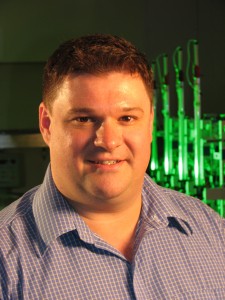 James Whisstock
James Whisstock
If proteins are the molecular building blocks of our bodies, then proteases are the demolition team – cutting up used proteins and breaking down damaged cells.
But who is in charge of the demolition team? In many cases it’s a group of molecules collectively known as serpins. When they don’t do their job properly, devastating diseases such as liver cirrhosis, thrombosis, dementia and Alzheimer’s disease can result.
James Whisstock is a serpins guru. He and his team are using x-ray crystallography, synchrotron light and other tools to piece together how serpins do their job – and what happens when they don’t. Along the way he is finding new opportunities for drug discovery.
At just 35 years of age, James has published more than 90 papers in high quality journals and leads a team of 18 researchers at Monash University.
For his discoveries of novel serpins, and his research leadership in protein biology, James Whisstock receives the 2006 Science Minister’s Prize for Life Scientist of the Year.
Ten years ago James left his home in the UK to join a new team researching proteases led by Professor Stuart Stone. Tragically, Professor Stone died before James arrived but Stone’s legacy was a team that has now developed into one of the largest concentrations of scientists studying these proteins in the world.
James “fell in love with Australia” – taking up citizenship in 2004. “It’s been a fabulous research environment. I have had fabulous mentors and collaborators, and that’s allowed my team to push the boundaries.”
Now with a five year programme grant from the National Health and Medical Research Council (NHMRC), as well as senior research fellowships from Monash University and the NHMRC, James has found the freedom and flexibility in Australia to identify and study key questions about proteases and serpins.
Among his group’s discoveries is the structure of a serpin that prevents breast and prostate cancer.
The team has also shown the key role that a serpin called MENT plays in packing two metres of DNA into the nucleus of each of our trillions of cells. Errors in the packaging process, however, can cause uncontrolled gene transcription and the development of cancers such as leukaemia.
Whisstock’s group has also identified the structure of antichymotrypsin, a serpin that polices the proteases involved in inflammation. Without this controller, the proteases could start destroying healthy tissue.
Until recently, serpins had only been found in multicellular organisms such as plants and higher animals. But James and his team have found them in bacteria, including some that live in very hot water – unusual as serpins can quickly be destroyed by heat. The bacteria’s ability to protect serpin structure could be of benefit to human biology.
James is currently leading a $6.5 million collaboration on protease systems biology, and is also director of the Victorian Bioinformatics Consortium. He is seen as a strong mentor, with one of his students recently receiving a Premier’s Award for the best PhD student in Victoria.
What of the future? Much of James’ work involves x-ray crystallography. “Synchrotron light has revolutionised the field. What once took years, now takes days,” says James. “So, several times a year I go to the US to get access to synchrotron light. Next year I will only have to travel a few hundred yards, to the new Australian synchrotron. It will have a profound effect on the speed of our discoveries.”
“I was greatly impressed, almost astonished, at the breadth and depth of research he was leading with his group and associates in Monash. His work, on the application of bioinformatics to areas with direct medical relevance, is proving to be exceptionally productive.”
Robin Carrell, Emeritus Professor of Haematology, University of Cambridge
“This is a brilliant career trajectory in a very short space of time.”
Professor Warwick Anderson, Chief Executive Officer, NHMRC
Autobiographical Details
2002- Scientific Director, Victorian Bioinformatics Consortium
2002- NHMRC Senior Research Fellow and Monash University Senior Logan Fellow
1999-2002 NHMRC Peter Doherty Fellow, Monash University Department of Biochemistry and Molecular Biology
1998-99 Monash University Research Fund Fellow, Monash University Department of Biochemistry and Molecular Biology
1997-98 Monash University Faculty of Medicine Research Fellow, Monash University Department of Biochemistry and Molecular Biology
1992-96 Ph.D. with the Department of Haematology, University of Cambridge, UK
1989-92 MA Hons, Natural Sciences, University of Cambridge, UK
1971 Born Ipswich, Suffolk, UK
Career Highlights
2005-09 A chief investigator with the ARC Centre of Excellence for Structural and Functional Microbial Genomics
2004-08 NHMRC Program Grant, “Protease Systems Biology”
2002 Invitrogen Award
2002 Victorian Young Tall Poppy Award
2000-02 Numerous travel awards, including an NHMRC Travelling Fellowship
Research highlights
Papers revealing the fine molecular detail of shape change in serpins as well as insights into how this change traps target proteases.
Described the x-ray crystal structure of the human tumour suppressor maspin, as well as the structure of myeloid and erythroid nuclear termination stage-specific protein (MENT), a serpin found in the nucleus which interacts with DNA. His group also discovered the first serpins in bacteria suggesting an ancient origin.
Using his knowledge of serpin biology, James has explored how other protein families can undergo inappropriate changes in shape. He has studied how single amino acid repeats are susceptible to mis-folding, a process which underlies several debilitating human neurodegenerative conditions such as Huntington’s disease.
More than 90 papers published in high quality journals.
Since 2002, James has led projects which have attracted funding of almost $8 million. These include a recent ARC LIEF grant to establish a high throughput protein production facility and a NHMRC program grant in Protease Systems Biology. Additionally, James is a chief investigator with the ARC Centre of Excellence for Structural and Functional Microbial Genomics ($17 million funding).
James has over 50 active national and international collaborators.
He has given over 50 invited seminars at universities and institutes around the world.


